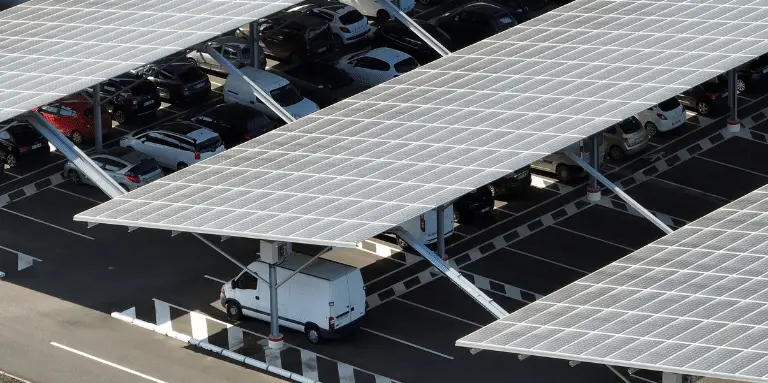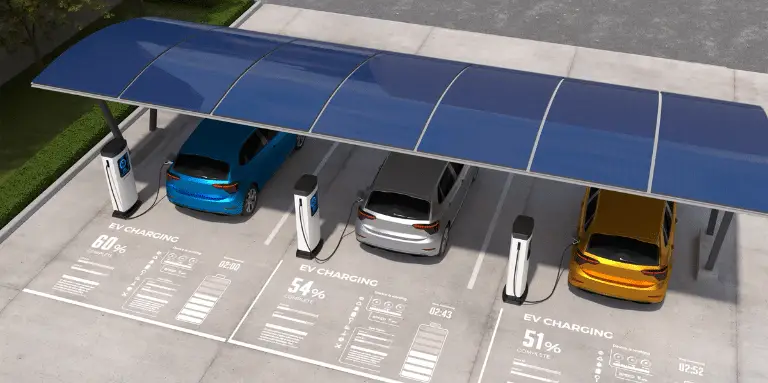You would like toto electric?
Beev offers multi-brand 100% electric vehicles at the best prices, as well as recharging solutions.
Car parks, a new space for solar energy production
How outdoor car parks can contribute to the energy transition
Outdoor car parks can contribute to the energy transition in a number of ways.
- Production of renewable energy
Installing photovoltaic shading systems on outdoor car parks is an effective way of producing renewable energy. The shades protect vehicles from the sun and rain, while generating electricity. The energy produced can be used to power adjacent buildings, the charging stations for electric carsor even the electricity grid.
- Reducing greenhouse gas emissions
The production of renewable energy helps to reduce greenhouse gas emissions, which are responsible for climate change. Installing photovoltaic shading systems on outdoor car parks therefore helps to combat climate change.
- Improving user comfort
Photovoltaic shading systems create a more comfortable parking space for users. They protect vehicles from the sun and rain, reducing vehicle temperatures and facilitating access in bad weather.
- Enhancing existing spaces
Installing photovoltaic shading systems on outdoor car parks makes it possible to make the most of areas that have already been artificially developed, without the need for new development. This helps to preserve natural areas and limit urban sprawl.
In France, a large number of projects to install photovoltaic shading systems on outdoor car parks have been completed or are currently under way.
For example, the city of Paris has installed photovoltaic shading on the car park at the Gare de Lyon, producing around 1.5 GWh of electricity per year.
La The city of Lyon has also installed photovoltaic shading on the car park of the Cité Internationale, producing around 1.2 GWh of electricity per year.
The energy transition is a major challenge for our society. Outdoor car parks can make a major contribution to this transition, by producing renewable energy, reducing greenhouse gas emissions, improving user comfort and enhancing the value of existing spaces.
The ApER law, better known as the EnR law, makes it compulsory to install photovoltaic panels on outdoor car parks.

The law on the acceleration of renewable energy production (ApER law), enacted on 10 March 2023, makes it compulsory to install photovoltaic shading on existing and future outdoor car parks of more than 1,500 m².
Article 40 of the law stipulates that the shaded areas must cover at least half the surface area of the car park. Car park managers may pool the work between several adjacent car parks, provided that they comply with the requirement to cover 50 % of the total surface area of the adjacent car parks.
This obligation aims to promote the development of renewable energies, in particular photovoltaics, and to reduce the environmental impact of car parks.
Photovoltaic shading allows electricity to be generated while protecting vehicles from the elements and heat.
The benefits and challenges of photovoltaic panels in car parksAdd your title here
There are many advantages to photovoltaic shading for car parks:
- Green electricity production: photovoltaic shading systems generate electricity from solar energy, helping to reduce greenhouse gas emissions.
- Vehicle shading: shading protects vehicles from bad weather and heat, which can extend their lifespan and reduce maintenance costs.
- Improved user comfort: shade structures can improve the comfort of car park users by providing a cooler, more pleasant place to park.
- New source of income: car park managers can sell the electricity generated by the shading systems, which can create a new source of income.
Photovoltaic shading systems also present a number of challenges:
- Investment cost: the installation of photovoltaic shading represents a significant initial cost.
- Lifespan: photovoltaic shading systems generally have a lifespan of 20 to 25 years.
- Maintenance: photovoltaic shading systems require regular maintenance, including cleaning of the solar panels.
- Impact on traffic: photovoltaic shading systems can have an impact on traffic, particularly by reducing vehicle visibility.
Obligation to provide car park shade: who is affected?
The car park shade obligation applies to all existing and future outdoor car parks over 1,500 m².
- Car parks for companies, local authorities, public establishments, establishments open to the public (ERP) and collective housing buildings.
- Car parks at shopping centres, railway stations, airports and other transport facilities
- Car parks for health establishments, educational establishments and other public establishments.
Car parks exempt from the obligation to install photovoltaic shade systems
- Historic monument car parks.
- Car parks on protected nature sites.
- Car parks for sports and cultural facilities with a surface area of less than 5,000 m².
Car parks undergoing major renovation are also exempt from the obligation, if the installation of photovoltaic shading is deemed economically unacceptable.
Car park managers must submit a preliminary works declaration to the town hall of the municipality in which the car park is located. The declaration must be accompanied by a file containing plans of the car park and details of the planned photovoltaic shading systems.
The deadline for bringing existing car parks into compliance is 1 July 2026. Visit car parks built after 1 July 2023 must be equipped with photovoltaic shading systems as soon as they are built.
In the event of non-compliance with the car park shade obligation, the car park manager is liable to a fine of €1,500 per day of delay.
How many photovoltaic panels should be installed?
The number of photovoltaic panels to be installed depends on the surface area of the car park and the power of the photovoltaic panels chosen.
Under the car park shade obligation, the shade must cover at least half the surface area of the car park. For example, for a 3,000 m² car park, 1,500 m² of the surface area will have to be shaded.
The power of photovoltaic panels varies according to their technology and characteristics. On average, a 1,500 m² photovoltaic shade can produce around 300 kWp.
For example, for a 3,000 m² car park, you would need to install around 100 photovoltaic panels, each with a capacity of 3 kWp.
It is important to note that these figures are given as a guide only. The number of photovoltaic panels to be installed must be determined by a qualified installer, based on the specific characteristics of the car park.
When choosing photovoltaic panels, it is important to take the following factors into account:
- The power of the photovoltaic panels: this determines how much electricity the panels can produce.
- Photovoltaic panel efficiency: this determines the amount of electricity produced per unit area.
- Photovoltaic panels generally last between 25 and 30 years.
- The price of photovoltaic panels varies according to their power, efficiency and brand.
It is also important to use a qualified installer for the installation of photovoltaic shading systems. The installer must hold the RGE (Reconnu Garant de l'Environnement) label.
Fines for failing to install photovoltaic panels in car parks?
In France, the installation of photovoltaic panels on outdoor car parks has been compulsory since 1 July 2023. This obligation applies to car parks larger than 1,500 m², whether public or private.
In the event of failure to comply with this obligation, the car park owner or operator is liable to an administrative fine. The amount of this fine is capped at :
- 20,000 per year for car parks with a surface area of less than 10,000 m² ;
- 40,000 per year for car parks with a surface area of 10,000 m² or more.
The fine is imposed by the prefect of the département in which the car park is located. It is collected by the public accountant.
The owner or operator of the car park may also be required to bring the installation into compliance under a penalty payment. The penalty is a sum of money that the owner or operator must pay to the Prefect every day that they fail to comply with the obligation to install photovoltaic panels.
How do you calculate the total cost of installing a photovoltaic shade?
The total cost of installing a photovoltaic shade is made up of several elements:
- The cost of the photovoltaic panels: this is the biggest cost, accounting for around 50 % of the total cost. The price of photovoltaic panels varies according to their power, efficiency and technology.
- Installation cost: this includes the cost of the shade structure, electrical wiring and commissioning. The cost of installation is generally between 30 and 50 % of the total cost.
- Ancillary costs: these include the cost of connection to the electricity grid, administrative costs and taxes. Ancillary costs are generally between 10 and 20 % of the total cost.
To calculate the total cost of installing a photovoltaic shade, you need to multiply the price of the photovoltaic panels by the number of panels required, then add the cost of installation and ancillary costs.
For example, for a 100 kWp shade, you will need to spend around €20,000 on the photovoltaic panels, €20,000 on the installation and €10,000 on ancillary costs. The total cost of installation is therefore €50,000.
It's important to note that the cost of installing a photovoltaic shade can vary depending on a number of factors, including :
- The location of the installation: costs are generally higher in urban than in rural areas.
- The size of the shadehouse: costs are proportional to the size of the shadehouse.
- The type of shade: fixed shade is generally less expensive than tiltable shade.
You can reduce the cost of installing a photovoltaic shade by taking advantage of the financial support available. In France, the government offers several forms of support, including the tax credit for energy transition (CITE), the self-consumption allowance (PAC) and the renewable energy investment allowance (PIE).
Aid for the installation of photovoltaic shade systems: a more accessible investment
Installing photovoltaic shading systems in car parks represents a major investment, which can be difficult for car park managers to recoup. To reduce the cost of these installations, there are a number of financial incentives available, including :
The self-consumption bonus
The self-consumption bonus is a government financial aid scheme that enables private individuals, professionals and local authorities to finance part of the cost of installing photovoltaic shade systems. Photovoltaic shade structures produce solar-generated electricity while protecting vehicles from bad weather.
Photovoltaic shading systems with a maximum capacity of 100 kWp are eligible for the self-consumption premium. For installations of more than 9 kWp, the premium is paid over a period of five years, while installations of less than 9 kWp receive a one-off payment. The amount of the premium is determined by the public authorities and is revised quarterly.
| Power of the installation | Amount of premium |
|---|---|
| ≤ 3 kWp | 370 € / kWp |
| ≤ 9 kWp | 280 € / kWp |
| ≤ 36 kWp | 200 € / kWp |
| ≤ 100 kWp | 100 € / kWp |
| ≤ 500 kWp | 0 € / kWp |
Self-consumption premium scale for Q4 2023 - valid until 31/01/2024
Surplus sale and total resale purchase tariffs
These tariffs are set by the government. They allow private individuals, professionals and local authorities who install photovoltaic panels to sell the surplus electricity they produce to the electricity grid.
| Feed-in tariff for selling surplus kWh | Feed-in tariff for kWh sold as a whole | ⩽ 3 kWp | 0,13€ | 0,17€ |
|---|---|---|
| ⩽ 9 kWp | 0,13€ | 0,15€ |
| ⩽ 36 kWp | 0,08€ | 0,14€ |
| ⩽ 100 kWp | 0,08€ | 0,12€ |
Price per kWh at the photovoltaic feed-in tariff - Q4 2023 (valid until 31/01/2024)
In addition to this public support, there is also private support available from energy suppliers, banks and local authorities. This can take the form of grants, reduced-rate loans or guarantees.
To benefit from this support, it is important to contact the relevant bodies for information. It's also important to prepare your photovoltaic shade installation project carefully, to maximise your chances of obtaining support.
Conclusion
The obligation to install photovoltaic panels on outdoor car parks is an ambitious measure designed to contribute to France's energy transition. It offers significant benefits, including the production of renewable energy, the reduction of greenhouse gas emissions, improved comfort for users and the enhancement of areas that have already been developed.
However, this measure also presents challenges, not least the initial investment cost, which can be high. It is therefore important to find out about the financial assistance available to reduce this cost.
If you would like to find out more aboutsupport for the installation of charging points for businesses in 2024For more information, see our article on this subject.
































